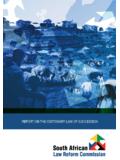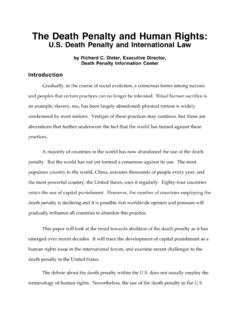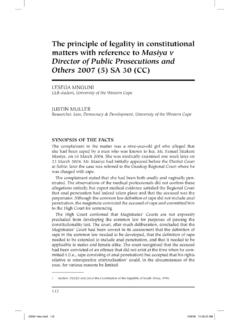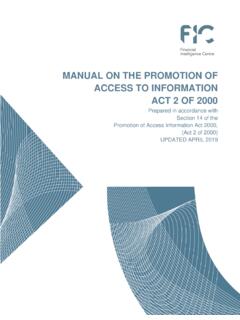Transcription of GUIDE TO FOOTNOTING IN LAW - UKZN School of Law
1 University of KwaZulu-Natal Library GUIDE TO FOOTNOTING IN LAW. This GUIDE is based on the style of the south african Law Journal Use this GUIDE in conjunction with the GUIDE to referencing in law List of works cited Examples of FOOTNOTING print sources are provided on pages 2-4; examples of FOOTNOTING electronic sources are provided on page 4. WHY IS REFERENCING IMPORTANT? To acknowledge the sources of information you have used just as authors of books and journal articles list the sources they have used. Even when you put information in your own words the source must be acknowledged. Basically, acknowledge any information that is not your own It is academic courtesy to acknowledge the work of others none of us know everything and rely on we the work of others Your lecturers/readers need to see from where you obtained your information Your lecturers/readers need to see how widely you have read; whether you have used key sources and how up to date your information is Your lecturers/readers may need to verify the information you have used Plagiarism using someone else's ideas as if they were your own is unacceptable and a punishable offence.
2 TERMINOLOGY USED IN THIS GUIDE . Citation a reference to a particular source of information you used Footnotes brief details of sources of information used, recorded at the bottom of the page on which the information source is referred to Source the published or unpublished source of information to which you have referred. The discipline of Law uses the FOOTNOTING system of referencing A. FOOTNOTES. When writing up an assignment you must acknowledge within the text of your assignment: details of the sources of facts and information and quotes you have used, where you use them the exact page/s on which the information was presented Your footnotes must reflect the sources you have actually used; you may not simply copy or transfer footnotes from a source into your own work Footnotes are also used in legal writing to provide extra information on an idea from the main part of your assignment that would otherwise make the main part of your assignment too clumsy You need to provide sufficient details for the reader to locate the item you are FOOTNOTING The details provided in a footnote are briefer than those provided in a list of works cited If the full information about a source is put in the text, do not repeat the details in a footnote.
3 Format When you have written something that needs to be referenced, the details of the source are placed at the bottom or foot' of the page (Microsoft Word can automatically footnote). In the text, a superscript number is placed at the end of the information (never start a sentence with a footnote number), fact or author's name and the corresponding footnote number at the bottom of the page has the details of the source next to it Particular details must be recorded, and recorded in a certain order. THE IMPORTANT THING ABOUT FORMAT IS TO BE CONSISTENT AND NEAT. 1. EXAMPLE OF FOOTNOTING . Text: Burchell1 indicates that the writ of habeas corpus was available for the release of persons unlawfully detained. Footnote: 1JM Burchell Principles of Criminal Law 2 ed (2005) 87.
4 OR. Text: The writ of habeas corpus was available for the release of persons unlawfully Footnote: 1JM Burchell Principles of Criminal Law 2 ed (2005) 87. Within the text of the assignment, references are numbered sequentially from 1 onwards to the end of the assignment. The footnotes at the bottom of the page are also numbered sequentially and in accordance with the in-text reference Items that are footnoted must be footnoted on the same page on which the references appear, not on the next page The details given in a footnote are usually briefer than in a list of works cited / bibliography: publisher details are excluded Author's initials appear first then the surname Authority eg cases and statutes are often referred to in footnotes.
5 If the name of the case/statute has been mentioned in text, the footnote will indicate only the year, law report details etc. Do not repeat the name of the case or statute Do not footnote indexes or databases they are the tools for getting to a source of information not the actual source of information itself. EXAMPLES OF FOOTNOTES FOR DIFFERENT SOURCES: PRINT SOURCES. 1. BOOKS including dictionaries, encyclopedias, reports Basic format: Initials and surname(s) of author(s) or editor(s) Title of book (title underlined if handwriting or in italics if typing) Edition (only when other than the first edition) Year in brackets Page/s. Publisher details are omitted in footnotes. Examples: Books by up to three authors J M Burchell & J R L Milton Principles of Criminal Law 2 ed (2000) 87.
6 Books by more than three authors E Du Toit et al Commentary on the Criminal Procedure Act (1987) 65. Books in multiple volumes R D Claassen Dictionary of Legal Words and Phrases 2 ed (1997) Vol 4: 876. Chapters or essays in books where different authors are responsible for different chapters (including LAWSA). J Pauldon The interim constitution' in J Rautenbach (ed) Constitutional Law in south Africa (2001) 26. M Wiechers Arson' in W A Joubert (founding ed)The Law of south Africa vol 26 First Reissue (1999) para 164. Corporate bodies as authors eg SA Law commission , companies, organizations south african Law commission (Project 123) Simplification of Criminal Procedure (1996) 8. south african Law commission discussion Paper 107 (Project 142) Report on Protected Disclosures (2007) para 56.
7 Reports of government departments including white papers, etc. Annual report of a government department south Africa Dept of Justice Annual Report (2002) 47. Commissions of inquiry and government committees (Chairperson of the commission is the author). M M Katz commission of Inquiry into Certain Aspects of the Tax Structure of south Africa: Eighth Interim Report (1994) 17-29. White papers south Africa Dept. of Environmental Affairs and Tourism White Paper: The Development and Promotion of Tourism in south Africa (1996) 124.*. *Exclude south Africa from name if you are only using south african material in an assignment. White Paper on Energy Policy (GN 3007 in GG 19606 of 17 December 1998). 2. PERIODICALS journals, magazines and newspapers Because all issues of a periodical have the same title, the volume, issue and page numbers must be indicated to differentiate between issues (these details are the address' of an article).
8 Titles of periodicals and not articles are in italics or underlined. This is because the journal is the important bit: an article cannot be located if the journal in which it appears is unknown. Each word of the journal title starts with a capital letter. You may abbreviate journal titles Publisher details are never required for periodical references For newspapers, use the day and month instead of volume and part number. Basic format: Initial(s) and surname(s) of author(s) Title of article (in quotation marks) Year (in brackets), volume and part number of journal Title of journal (italics or underlined) Page/s from which information taken. Law often abbreviates the titles of journals Examples: Journal or magazine article P Brown The meaning of culpa' (1996) 89(1) Oxbridge Law Quarterly (OR ) 107.
9 S P Moyo The decline and fall of constitutionalism' 2006 Acta Juridica 43*. *When the journal has no volume number the year is not placed in brackets. Newspaper articles Man probed over human trafficking' Natal Witness 27 May 2005 at 3.*. * If there is no author, start with the title. 3. CASES. The first time you refer to a case in the text by its name, the citation must be in full in the footnotes as per footnote example 25 below Thereafter when referring again to the case in the text it is acceptable to refer to it in an abbreviated form. There are various options for doing this eg Khumalo v Chetty can be referred to as Khumalo's case. In the footnotes you may also use the short cut supra which means the afore- mentioned case (literally the above case) see below You may choose to put the full citation in text instead of a footnote Remember that the names of the parties of a case are always in italics when typed or underlined if writing.
10 Examples of case citation (if names of parties given in text, only put citation in footnote). 25. Khumalo v Chetty 2004 (3) SA 341 (C). 26. 1999 (2) SACR 452 (C). 27. Dlamini v Jacobs (NPD) unreported case no 98/05 of 3 August 2006. 28. Khumalo v Chetty supra at para 342G OR Khumalo v Chetty supra note 22 or Khumalo (note 22 above). 4. LEGISLATION. In text you usually refer to the statute in full the first time, thereafter just by name with the act number and year etc in the footnote. If you are referring to a statute several times in the text you can put in brackets after the first reference: (hereafter referred to as the Act) OR (hereafter referred to as the Schools Act). Statute citations must include the short name of the statute, its number and year and then the relevant section (s); subsection (ss); chapter (ch) etc.







